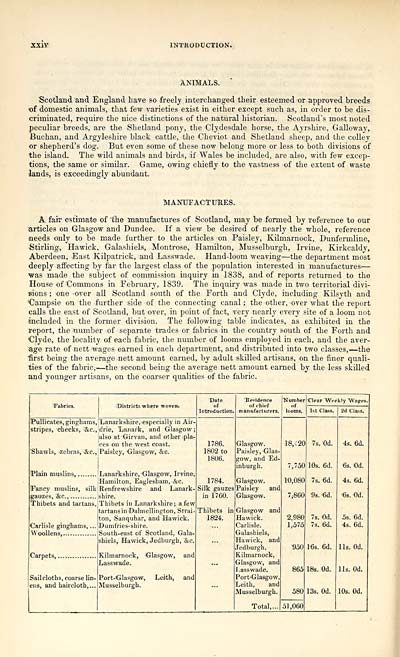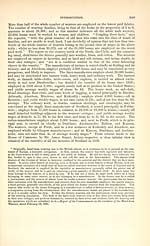Topographical, statistical, and historical gazetteer of Scotland > Volume 1
(36) Page xxiv
Download files
Complete book:
Individual page:
Thumbnail gallery: Grid view | List view

XXIV
INTRODUCTION,
ANIMALS.
Scotland and England have so freely interchanged their esteemed or approved breeds
■of domestic animals, that few varieties exist in either except such as, in order to be dis-
criminated, require the nice distinctions of the natural historian. Scotland's most noted
peculiar breeds, are the Shetland pony, the Clydesdale horse, the Ayrshire, Galloway,
Buchan, and Argyllshire black cattle, the Cheviot and Shetland sheep, and the colley
or shepherd's dog. But even some of these now belong more or less to both divisions of
the island. The wild animals and birds, if Wales be included, are also, with few excep-
tions, the same or similar. Game, owing chiefly to the vastness of the extent of waste
lands, is exceedingly abundant.
MANUFACTURES.
A fair estimate of the manufactures of Scotland, may be formed by reference to otir
articles on Glasgow and Dundee. If a view be desired of nearly the whole, reference
aeeds only to be made further to the articles -on Paisley, Kilmarnock, Dunfermline,
■Stirling, Hawick, Galashiels, Montrose, Hamilton, Musselburgh, Irvine, Kirkcaldy,
Aberdeen, East Kilpatrick, and Lasswade. Hand-loom weaving — the department most
deeply affecting by far the largest class of the population interested in manufactures- —
was made the subject of commission inquiry in 1838, and of reports returned to the
House of Commons in February, 1839. The inquiry was made in two territorial divi-
sions ; one «over all Scotland south of the Forth and Clyde, including Kilsyth and
'Campsie on the further side of the connecting canal ; the other, over what the report
calls the east of Scotland, but over, in point of fact, very nearly every site of a loom not
included in the former division. The following table indicates, as exhibited in the
report, the number of separate trades or fabrics in the country south of the Forth and
•Clyde, the locality of each fabric, the number of looms employed in each, and the aver-
age rate of nett wages earned in each department, and distributed into two classes, — the
first being the average nett amount earned, by adult skilled artisans, on the finer quali-
ties of the fabric, — the second being the average nett amount earned by the less skilled
and younger artisans, on the coarser qualities of the fabric.
Fabrics.
-Districts where woven.
Pullicates, ginghams, Lanarkshire.especially in Air-
stripes, checks, &.C., drie, Lanark, and Glasgow;
also at Girvan, and other pla-
ices on the west coast.
Shawls, -zebras, &c,
Plain muslins, ........
Fancy muslins, silk
gauzes, &c,
Thibets and tartans,
Carlisle ginghams, ...
Woollens, ,. ............
Carpets,.... ......
Sailcloths, coarse lin-
ens, and haircloth,...
Paisley, Glasgow, &c.
Lanarkshire, Glasgow, Irvine,
Hamilton, Eaglesham, &c.
Renfrewshire and Lanark-
shire.
Thibets in Lanarkshire ; a few
tartans in Dalmellington, Strai
ton, Sanquhar, and Hawick.
Dumfries-shire.
South-east of Scotland, Gala-
shiels, Hawick, Jedburgh, &c.
Kilmarnock, Glasgow, and
Lasswade.
Port-Glasgow,
Musselburgh.
Leith, and
Date
of
Introduction.
ReFidence
"Number
Clear Weekly "Wages.
manufacturers.
looms.
1st Class.
2d Class.
1786.
Glasgow.
18,-: 20
7s. 0d.
4s. 6d.
1802 to
Paisley, Glas-
1806.
gow, and Ed-
inburgh.
7,750
10s. 6d.
6s. Od.
1784.
Glasgow.
10,080
7s. 6d.
4s. 6d.
Silk gauzes
Paisley and
in 1760.
Glasgow.
7,860
9s. -6d.
'6s. Od.
Thibets in
Glasgow and
1824.
Hawick.
2,980
7s. Od.
5s. 6d.
Carlisle.
1,575
7s. 6d.
4s. 6d.
Galashiels,
...
Hawick, and
Jedburgh.
■950
16s. 6d.
lis. Od.
Kilmarnock,
«■•
Glasgow, and
Lasswade.
865
18s. Od.
lis. Od.
Port-Glasgow,
Leith, and
Musselburgh.
580
13s. Od.
10s. Od.
Total,...|
51,060
INTRODUCTION,
ANIMALS.
Scotland and England have so freely interchanged their esteemed or approved breeds
■of domestic animals, that few varieties exist in either except such as, in order to be dis-
criminated, require the nice distinctions of the natural historian. Scotland's most noted
peculiar breeds, are the Shetland pony, the Clydesdale horse, the Ayrshire, Galloway,
Buchan, and Argyllshire black cattle, the Cheviot and Shetland sheep, and the colley
or shepherd's dog. But even some of these now belong more or less to both divisions of
the island. The wild animals and birds, if Wales be included, are also, with few excep-
tions, the same or similar. Game, owing chiefly to the vastness of the extent of waste
lands, is exceedingly abundant.
MANUFACTURES.
A fair estimate of the manufactures of Scotland, may be formed by reference to otir
articles on Glasgow and Dundee. If a view be desired of nearly the whole, reference
aeeds only to be made further to the articles -on Paisley, Kilmarnock, Dunfermline,
■Stirling, Hawick, Galashiels, Montrose, Hamilton, Musselburgh, Irvine, Kirkcaldy,
Aberdeen, East Kilpatrick, and Lasswade. Hand-loom weaving — the department most
deeply affecting by far the largest class of the population interested in manufactures- —
was made the subject of commission inquiry in 1838, and of reports returned to the
House of Commons in February, 1839. The inquiry was made in two territorial divi-
sions ; one «over all Scotland south of the Forth and Clyde, including Kilsyth and
'Campsie on the further side of the connecting canal ; the other, over what the report
calls the east of Scotland, but over, in point of fact, very nearly every site of a loom not
included in the former division. The following table indicates, as exhibited in the
report, the number of separate trades or fabrics in the country south of the Forth and
•Clyde, the locality of each fabric, the number of looms employed in each, and the aver-
age rate of nett wages earned in each department, and distributed into two classes, — the
first being the average nett amount earned, by adult skilled artisans, on the finer quali-
ties of the fabric, — the second being the average nett amount earned by the less skilled
and younger artisans, on the coarser qualities of the fabric.
Fabrics.
-Districts where woven.
Pullicates, ginghams, Lanarkshire.especially in Air-
stripes, checks, &.C., drie, Lanark, and Glasgow;
also at Girvan, and other pla-
ices on the west coast.
Shawls, -zebras, &c,
Plain muslins, ........
Fancy muslins, silk
gauzes, &c,
Thibets and tartans,
Carlisle ginghams, ...
Woollens, ,. ............
Carpets,.... ......
Sailcloths, coarse lin-
ens, and haircloth,...
Paisley, Glasgow, &c.
Lanarkshire, Glasgow, Irvine,
Hamilton, Eaglesham, &c.
Renfrewshire and Lanark-
shire.
Thibets in Lanarkshire ; a few
tartans in Dalmellington, Strai
ton, Sanquhar, and Hawick.
Dumfries-shire.
South-east of Scotland, Gala-
shiels, Hawick, Jedburgh, &c.
Kilmarnock, Glasgow, and
Lasswade.
Port-Glasgow,
Musselburgh.
Leith, and
Date
of
Introduction.
ReFidence
"Number
Clear Weekly "Wages.
manufacturers.
looms.
1st Class.
2d Class.
1786.
Glasgow.
18,-: 20
7s. 0d.
4s. 6d.
1802 to
Paisley, Glas-
1806.
gow, and Ed-
inburgh.
7,750
10s. 6d.
6s. Od.
1784.
Glasgow.
10,080
7s. 6d.
4s. 6d.
Silk gauzes
Paisley and
in 1760.
Glasgow.
7,860
9s. -6d.
'6s. Od.
Thibets in
Glasgow and
1824.
Hawick.
2,980
7s. Od.
5s. 6d.
Carlisle.
1,575
7s. 6d.
4s. 6d.
Galashiels,
...
Hawick, and
Jedburgh.
■950
16s. 6d.
lis. Od.
Kilmarnock,
«■•
Glasgow, and
Lasswade.
865
18s. Od.
lis. Od.
Port-Glasgow,
Leith, and
Musselburgh.
580
13s. Od.
10s. Od.
Total,...|
51,060
Set display mode to: Large image | Transcription
Images and transcriptions on this page, including medium image downloads, may be used under the Creative Commons Attribution 4.0 International Licence unless otherwise stated. ![]()
| Gazetteers of Scotland, 1803-1901 > Topographical, statistical, and historical gazetteer of Scotland > Volume 1 > (36) Page xxiv |
|---|
| Permanent URL | https://digital.nls.uk/97437978 |
|---|
| Description | Volume first. A-H. |
|---|---|
| Attribution and copyright: |
|

